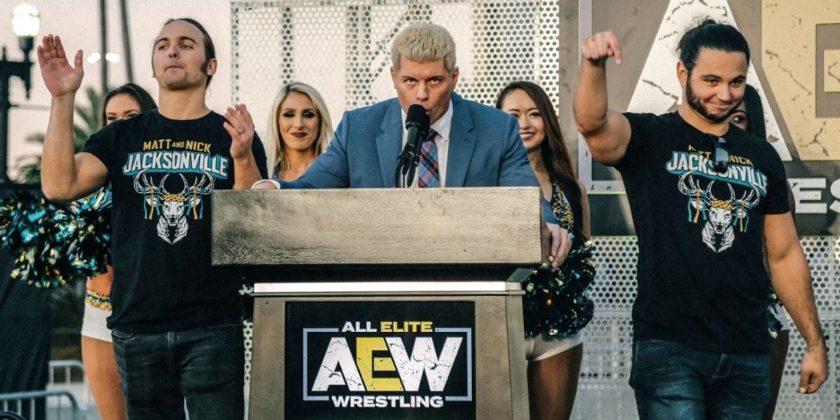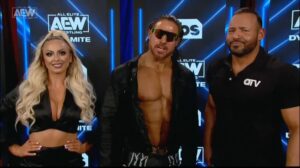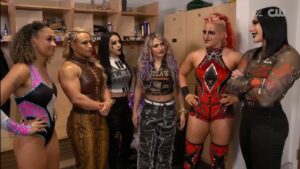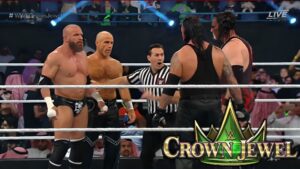In this series, James Staynings takes a deep dive into AEW’s short but impactful history, its present, and its future.
After exploring AEW’s past in the first two parts, James will examine AEW’s present using Double or Nothing as a case study. In the final part, James will discuss AEW’s future. This will include discussing the problems that AEW faces and questions Tony Khan will have to address.
Briefest of Celebrations
AEW’s five-year anniversary has come and gone. Celebrations of the company’s existence, its influence, and how its helped redefine wrestling over the past half-decade were brief. The wheels of the wrestling news cycle keep turning. Onwards and onwards, seemingly spinning faster and faster.
Post Double or Nothing, the landscape changed again. First, the Prohibited Portal. Jordynne Grace’s NXT appearance stole headlines. Then Dynamite’s shocking ending.
The unpredictable decision to bring Will Ospreay vs. Swerve Strickland ahead of All In to Forbidden Door. Then, on the May 31 edition of SmackDown, AJ Styles faked his retirement to set up another match with Cody Rhodes. The cycle never stops.
AEW itself arguably has not celebrated its own short history to the fullest extent. The company continually focuses on what’s next. Something that makes them different to WWE whose RP machine will tout every achievement, rightly, with hyperbole.
AEW itself moves too quickly, which is a problem I’ll discuss in a later article. At times, Tony Khan and the company can be too modest. At other times, Khan and its stars have self-righteously promoted AEW as saving wrestling, making them a lightning rod for criticism.
Removing the RP spin, AEW has helped redefine pro wrestling. Regardless of AEW’s current commercial and critical reception, in five years, AEW has brought more competition to wrestling. AEW had redefined old concepts and added new layers. It has even changed WWE in two noticeable ways.
The Young Bucks, Kenny Omega, and Cody Rhodes – with the backing of Tony Khan – did change the world.
Change Didn’t Always Mean Change
In the history of my fandom, it’s true to say wrestling changed, but not always for the benefit of the fans or industry. I became a fan at the start of The Ruthless Aggression Era.
I watched John Cena transform. From a street-smart rapper with an anti-establishment edge to a shirt model and the leader of conformity, the poster child for the establishment, during the PG Era. From multiple to one-dimensional.
The familiar repetitive booking patterns grew more childish while I was growing up. My love of stories was growing with nuance and sophistication. Mainstream wrestling was caught in arrested development.
By The Reality Era, I had lost hope that Bryan Danielson and CM Punk would be treated seriously. I, like many, gave up on WWE. Instead, only keeping touch on the product weekly through wrestling news sites where I discovered alternatives like ROH, TNA, and PWG.
The New Era felt like rinse and repeat. Some new faces, the same issues. The same restrained repetitive creative. Only room for one wrestler at the head of the table, holding up like Atlas the brand’s three initials, the true draw.
Creative wrestlers like Bray Wyatt were broken down. Those who did break through the glass ceiling, like Becky Lynch, still felt trapped within restrictions. Characters stuck in the perimeters of a bell jar.
Punk was not telling lies when he famously said Vince McMahon would make money despite himself. Increasing WWE’s brand, history, and content library brought profitability. WWE was a bankable commodity for TV networks.
There was no incentive to change what financially wasn’t broken. Despite this, many wrestling legends, even on shows on the WWE Network like The Legends of Wrestling roundtable, talked about how to be its best again, WWE needed competition. The catalyst emerged in 2019.
AEW’s Creative Success- What’s Old is New
AEW by no means reinvented the wheel. Beloved stipulation matches, from Stadium Stampede, Anarchy in the Arena, Blood and Guts and the newly created Casino Gauntlet match all have taken their inspiration from previous match types in WWE and beyond.
The concept of long-term planning, long-term storyline, and character development were missing in WWE due to weekly changes and lack of foresight. Beyond a few examples, for specific stars, long-term storytelling seemed locked up in a WWE warehouse with the Smackdown fist.
AEW drew on wrestling history. WCW, ECW, Japan, and the Indies to make things that were old and long touted as important new again. Things WWE had taken for granted.
Wins and losses mattered. AEW refocused their wrestling product on the sports aspects with the wrestling being central to the show. Instead of WWE, where to paraphrase Lance Storm, Raw was (at times still is) a show about booking a wrestling event.
From the first PPV, Double or Nothing, the seeds for long-term stories and rivalries were not only planted. Over time, the shoots were craftily weaved through the trellis framework of AEW’s weekly programming to help key characters progress.
Kenny Omega, “Hangman” Adam Page, and Jon Moxley were foreshadowed as future world champions while being fleshed out into engaging characters with their own unique arcs.
Adding Spikes to It
Yet at their peak, AEW elevated with nuance and clever characterization. Smart, thoughtful booking brought a sense of realness to some of their top wrestlers’ characters.
Moxley, who has become one of the greatest transitional champions in history, felt like a hero during the Pandemic and when AEW needed a leader. Wrestlers like Page and Eddie Kingston presented aspects of masculinity and mental health issues in a way that felt true to life rather than caricature. This presented a more modern approach to masculinity in the traditionalist world of wrestling.
Although some talk of The Bloodline as the greatest storyline in modern wrestling history, some would argue that the reality-bleeding war between MJF and CM Punk is the storyline of the century. Through detailed storytelling, AEW created characters who felt like people rather than superstars.
Dovetailing of storylines and conflicts occurred with wrestlers’ arcs and issues overlapping. The locker room was made to feel like an organic place where people’s issues did not occur in a bubble. Wrestlers didn’t just suddenly forget the issues they had with each other conveniently three months or a year later.
In the ring, a variety of wrestling styles, and ice cream flavours have and are showcased on a weekly basis. Lucha wrestling, strong style, indy-rific sprints, hardcore, and deathmatch wrestling.
Old school stipulations and call backs to wrestling history. Trios action that when fresh, gave something new and distinct to AEW.
Yes, over time, these spikes have been worn down. Things that were once fundamental to AEW, integral, some would say are currently missing.
WWE Hasn’t Changed What Worked
Some might say, WWE does some of these things. They would be right. Now and currently, they do.
WWE was always capable of when they wanted to of telling long-term stories. Whether by design or accident. From The Undertaker’s streak to building Roman Reign’s lauded Tribal Chief story on the bones of failed attempts at getting him over.
While running NXT Black and Gold, Triple H was praised for long-term storytelling. So, it would be speculative at best to imply how AEW has impacted WWE’s booking philosophy.
However, given WWE’s history of repackaging and remolding wrestlers in their image, it’s interesting to note of those wrestlers who have left AEW, how very few of them have dramatically changed in character or presentation.
Cody Rhodes retained what worked in AEW. Including his music. Rhodes’ most significant change was dropping the pretense that babyfaces and heels don’t matter anymore. Leaning into being the good guy, Rhodes is the new face of WWE.
Jade Cargill, in terms of in-ring and persona, remains similar to AEW with the only change being an amplification of her presentation. Shawn Spears is still doing his chairman gimmick. Only Alexis King has had a major gimmick reshuffle and discussion around his viability as a future star is debatable.
If it didn’t work, WWE would have changed it. Instead, the biggest changes have been strengthening presentation. This implies that AEW’s creative or allowing wrestlers the freedom to develop their characters must have done something right.
WWE under Triple H is now credited as more free-flowing and collaborative which, while not caused by AEW directly, notes a significant shift in the direction of the business. In part two, I’ll discuss more about how wrestlers, whether signed to AEW, WWE or on the indies, have had their livelihoods changed due to competition.
Changes to NXT and Making Stars
NXT is the most notable aspect of WWE that AEW has changed. The overhaul, the complete redesign of development after the “Wednesday Night War” is WWE’s most notable change to wrestling outside of their universe.
As Forbes writer Blake Oestriecher recognized in his 2021 article “How AEW Changed WWE and Pro Wrestling”, one of AEW’s biggest successes:
“Whether WWE would admit it or not, completely changed the way WWE is trying to create new stars, too.
That’s evidenced by the end of the NXT of old, as WWE has completely distanced itself from the NXT that once made five-star matches a common occurrence. NXT, now dubbed NXT 2.0, has done a 180, shifting its focus to transforming college athletes into WWE superstars instead of its previous long-running strategy of signing independent wrestling stalwarts who already had name value in the pro wrestling world.”
Transcript from Forbes.
Regardless of the current debate about how successful AEW’s home-grown talent is, competition caused WWE to re-think how and where it gets its talent from. Diversifying where they are getting their talent from is allowing WWE to broaden its recruitment reach.
Change to Inter-promotional Relationship
Previously, WWE had carte blanche to the talent available on the US and world indy scenes. Some companies, like Evolve and FCW vanished after working with WWE. The closure of NXT UK and TKO Holdings perceived desire to make a profit may make a global development system a dream.
Ring of Honour acted as a pipeline for WWE, even when they had NXT. Its alumni, including Kevin Owens and Sami Zayn, remain stabilizing pillars on WWE’s rosters. However, that pipeline is closed. Instead, operated by AEW.
WWE was put into a position of having to co-operate and co-ordinate with other wrestling companies in what my colleague, Will Gray, termed Pro Wrestling’s Cold War. It was not that long ago WWE tried to court and work together with AEW’s Forbidden Door partner, NJPW.
This week the wrestling community is still ablaze talking about a TNA wrestler on WWE’s developmental brand and what’s possible next. AEW viewers have been spoiled for years by the Forbidden Door becoming an invisible open border with the stars of CMLL, NJPW, and the indies popping in for a day visit.
For WWE viewers, this is exciting new ground.
I, imagine in weeks to go, the debate from some tribalists will turn to arguing how WWE did this better than AEW, while ignoring AEW made this situation a reality. We as fans are benefitting from getting to see cross-promotion that we could not have imagined before.
Yes, WWE has worked collaboratively before. Historically, they have tried invasions with ECW stars in 1997 and the NWA in 1998, with nothing long-lasting, or sustained. Even when WWE worked with Japanese promotions and shared championships overseas, the collaborations did not allow the current extent of co-operation and cross-pollination we are currently enjoying.
Conclusion: Competition Makes Change
Innovation only happens when companies and individuals are pushed in some way beyond our comfort zone. WWE has always responded to competition, even when small. Even the potential threat of TNA Wrestling challenging Raw on a Monday night led to the return of Bret “The Hitman” Hart to the promotion after the Montreal Screwjob.
The presence, pressure, and threat in any sport or industry causes changes. Those who benefit most are not just the businesses themselves.
We, as fans, consumers, as well as the wrestlers themselves, have and are benefitting greatly from competition. This will be the focus of part two later this week.
Looking for More Deep Dive Content?
If you’re also a WWE fan, James has done a series of articles examining the start of the Paul Levesque Era of WWE post-Wrestlemania XL and the impact of Vince McMahon leaving the promotion.
The first examines how The Paul Levesque Era has tried to move on from McMahonism while retaining key elements of Vince’s infrastructure (here). The second, James discusses how WWE has fulfilled fans’ long-desired wishes. The third discusses AEW and how its relationship with WWE has changed since Vince McMahon has left TKO Holdings (here).
More From LWOS Pro Wrestling
Header photo – AEW – Stay tuned to the Last Word on Pro Wrestling for more on this and other stories from around the world of wrestling, as they develop. You can always count on LWOPW to be on top of the major news in the wrestling world. As well as to provide you with analysis, previews, videos, interviews, and editorials on the wrestling world. You can catch AEW Dynamite on Wednesday nights at 8 PM ET on TBS. AEW Rampage airs on TNT at 10 PM EST every Friday night. AEW Collision airs Saturday at 8pm Eastern on TNT. More AEW content available on their YouTube.






